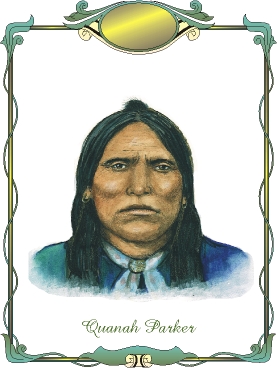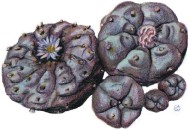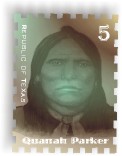 Expand 20 messages, 1 to 20 of 63
Expand 20 messages, 1 to 20 of 63  trapper/kcmo
9 y
1,633
trapper/kcmo
9 y
1,633

 Re: diagnosis
Re: diagnosis  trapper/kcmo
9 y
1,943
This is a reply to # 2,256,168
trapper/kcmo
9 y
1,943
This is a reply to # 2,256,168this would be cool if not for living in a mickey mouse nation:
http://www.stainblue.com/quanahparker.html
Quanah Parker, born ca. 1845 in Oklahoma, was chief of the Quahadi Comanches, the last band to surrender in the South Plains war of 1874-1875. His father Peta Nocona was a revered war chief of the Nocone Comanches. His mother Cynthia was a white woman who as a child had been captured by the Comanches on May 19, 1836, at Fort Parker, in Limestone County, Texas.
Parker was influential in the spread of Christian peyotism among the Plains Indians. He was the first to integrate highly ritualized Christian elements with the Indians' traditional use of peyote, and insisted that women not be excluded from such ceremonies. The town of Quanah, Texas -- settled in 1884 and named for Quanah Parker -- is the seat of Hardeman County, in North Texas.
Today, bona fide religious use of peyote by such organizations as the Native American Church continues and is protected by the Fourteenth Amendment of the U.S. Constitution as well as several sections of the Arizona Constitution pursuant to Arizona State Judge Yale McFate's July 26, 1960 ruling. States permitting the religious use of peyote include Texas, Kansas, Oklahoma, New Mexico, Arizona, Colorado, Utah, Minnesota and Nevada, among others.
 Above: Peyote (Lophophora williamsii).
Above: Peyote (Lophophora williamsii).
Aquarelle by Carol Ann Wells. Courtesy The Stain Blue Museum Collection.Peyote, Cactus Pudding, Dry Whiskey and White Mule are some of the common names given this sacred cactus that contains more than fifty alkaloids and related compounds. Mescaline (3,4,5-trimethoxy-beta-phenethylamine) is structurally similar to the human neurohormone epinephrine and is the primary active constituent of peyote. It produces the indescribable, brilliantly colored visions that are the hallmark of the peyote experience. Aldous Huxley's book, The Doors of Perception, vividly describes his experience while under the influence of mescaline and was an important milestone in the history of psychedelics.
 Above: "Peyotist Postage Stamp."
Above: "Peyotist Postage Stamp."
Artistamp created by D. Smith. Courtesy The Stain Blue Museum Collection.Once common throughout its range in Texas (Starr, Hidalgo, and Zapata counties), peyote is now a rare plant due to overcollecting. A substantial population still survives in Mexico's Chihuahuan Desert. Cultivating peyote is a rewarding experience but requires great patience: If started from seed, it can take up to five years to obtain a plant that is 15 mm in diameter. "Pups," or lateral shoots arising from lateral areoles, can be removed and allowed to callus, and then planted in moist sand or a sand/vermiculite mixture where they will quickly form adventitious roots.
Please support the Peyote Foundation.
Required ReadingAnderson, E.F. "The biogeography, ecology and taxonomy of Lophophora (Cactaceae)." Brittonia 21(4): 299-310 (1969).
Anderson, E.F. Peyote: The Divine Cactus. University of Arizona Press, Tucson, AZ (1980).
Anderson, E.F. "The peyote gardens of south Texas: A conservation crisis?" Cactus & Succulent Journal 67(2): 67-73 (1995).
Huxley, A. The Doors of Perception. Harper, New York (1954).
La Barre, W. The Peyote Cult. Yale University Press, New Haven, CT (1938).
La Barre, W. "Mescalism and peyotism." American Anthropologist 59: 708-711 (1957).
La Barre, W. "Twenty years of peyote studies." Current Anthropology 1: 45-60 (1960).
La Barre, W. "Peyotl and mescaline." Journal of Psychedelic Drugs 11(1-2): 33-39 (1979).
La Barre, W. et al. "Statement on peyote." Science 114: 582-583 (1951).
Schultes, R.E. and A. Hofmann. The Botany and Chemistry of Hallucinogens. Charles C. Thomas, Springfield, IL (1973).
Shulgin, A. "Mescaline: The chemistry and pharmacology of its analogs." Lloydia 36(1): 46-58 (1973).
Shulgin, A. "Profiles of psychedelic drugs. 7. Mescaline." Journal of Psychedelic Drugs 11(4): 355 (1979).
The Ones That Stain Blue:
Maria Sabina Profile | Albert Hofmann Profile
Gaston Guzman Profile | Andrew Weil Profile
Psilocybe cubensis Profile | Psilocybe hoogshagenii Profile
Psilocybe mexicana Profile | Psilocybe muliercula Profile
Psilocybe zapotecorum Profile
Meet the Stain Blue Artist | Links | Home
Copyright © 1996-2000 Stain Blue Press

More
- Re: diagnosis trapper/kcmo
9 y
1,710
MoreThis is a reply to # 2,256,170as an antibiotic:
http://www.psychedelic-library.org/antibiot.htm
Antibiotic Activity of an Extract Of Peyote
David L. Walkington
Economic Botany, 1960
The use of peyote in religious rites by many Indian tribes is common knowledge. In addition, curative properties for such varied ailments as toothache, pain in childbirth, fever, breast pain, skin diseases, rheumatism, diabetes, colds, and blindness, among other things, have been claimed for this plant by the same peoples...The U.S. DISPENSATORY lists peyote under the name Anhalonium and indicates its use to some extent in various forms for neurasthenia and hysteria and also in cases of asthma...
Extracts of whole peyote plants were prepared in various solvents and screened for antimicrobial activity...and showed positive microbial inhibition...the principle antibiotic substance was given the name Peyocactin.
Swiss-Webster white mice were used for preliminary animal toxicity tests and protection studies to indicate the degree of inhibitory action of peocactin against fatal staphylococcal infection. In every case the protected animals survived while those in the control group succumbed within 60 hours after infection with S. aureus... Summary: A water-soluble crystalline substance separated from an ethanol extract of Lophophora williamsii... exhibited antibiotic activity against a wide spectrum of bacteria and a species of the imperfect fungi...Of particular interest was its inhibitory action against 18 strains of penicillin-resistant Staphylococcus aureus.
—David L. Walkington
Department of Bacteriology
University of Arizona-
 Re: diagnosis trapper/kcmo
9 y
1,594
This is a reply to # 2,256,202
Re: diagnosis trapper/kcmo
9 y
1,594
This is a reply to # 2,256,202http://en.wikipedia.org/wiki/Quanah_Parker
Founder of the Native American Church Movement
Quanah Parker is credited as one of the first important leaders of the Native American Church movement.[13] Parker adopted the peyote religion after having been gored in southern Texas by a bull.[citation needed] Parker was visiting his mother's brother, John Parker, in Texas where he was attacked, giving him severe wounds. To fight an onset of blood burning fever, a Mexican curandera was summoned and she prepared a strong peyote tea from fresh peyote to heal him. Thereafter, Quanah Parker became involved with peyote, which contains hordenine, mescaline or phenylethylamine alkaloids, and tyramine which act as natural antibiotics when taken in a combined form. Clinical studies indicate that peyocactin, a water-soluble crystalline substance separated from an ethanol extract of the plant, proved an effective antibiotic against 18 strains of penicillin-resistant Staphylococcus aureus, several other bacteria, and a fungus.[14]
Parker taught that the sacred peyote medicine was the sacrament given to the Indian peoples and was to be used with water when taking communion in a traditional Native American Church medicine ceremony. Parker was a proponent of the "half-moon" style of the peyote ceremony. The "cross" ceremony later evolved in Oklahoma because of Caddo influences introduced by John Wilson, a Caddo-Delaware religious leader who traveled extensively around the same time as Parker during the early days of the Native American Church movement.
Parker's most famous teaching regarding the spirituality of the Native American Church:
- "The White Man goes into his church and talks about Jesus. The Indian goes into his tipi and talks with Jesus."[citation needed]
The modern reservation era in Native American history began with the adoption of the Native American Church and Christianity by nearly every Native American tribe and culture within North American and Canada as a result of Parker and Wilson's efforts. The peyote religion and the Native American Church were never the traditional religious practice of North American Indian cultures. This religion developed in the nineteenth century, inspired by events of the time being east and west of the Mississippi River, Parker's leadership, and influences from Native Americans of Mexico and other southern tribes.[15][16][17][18][19][20] They had used peyote in spiritual practices since ancient times.

-
- Re: diagnosis trapper/kcmo
9 y
1,710
- Re: diagnosis Newport
9 y
1,570
This is a reply to # 2,256,168..I still have a few doses but just in case I started a batch:
-250ml jar
-2/3 full with Blue Vervaine dry with stalks
-Ice cold Vodka to fill half way
-then drizzle cold soda water till almost no space left
-cap it, leave a room temp
Everclear is better but all I had is Tequila so no matter what just adjust the ratio for Everclear..
The stems contain the most active ingredient but if you make two batches you can use the first batch starting the next day and use the pulp left over as poultice since it hasn't been fully extracted..
We have discussed many tricks in the past including using Ozone and Vinegars to speed up extraction.. all lost to CIAoogle...
- Ignore Bartonella and Die Newport
9 y
1,672
This is a reply to # 2,256,177This folder contains a PDF name "Ignore Bartonella and Die" http://1drv.ms/1o9GAB4
Bart has always been one of those things I downplayed. Protected by the Dragon himself these are nearly impossible to treat for any length of time.
FYI: The dose of Blue Vervaine I just took was highly effective against Bart.. times a changing..
- Re: Ignore Bartonella and Die trapper/kcmo
9 y
1,475
- Re: Ignore Bartonella and Die trapper/kcmo
9 y
1,475
- my instructions for vervaine (offic.... johng
9 y
2,205
RR Educational
This is a reply to # 2,256,177i assume same instructions would work for blue vervain...
– 1L Wide Mouth Mason jar,
– 75g of Real Vervaine
– in a mixing bowl (glass) mix 75g vervain with 250 Ml 20% vinegar, stir and mash for several minutes and all thoroughly moist ( i used a large wooden spoon)
– use a rubber spatula (these have a name, but can’t think of it) to scoop the wet vervain into the mason jar. If jar lid is metal, first cover the jar opening with wax paper, then close the lid.
after (_____) days, then add
– 300g of Vodka (80 proof/40%), room temp, or 125Ml (or grams, same thing) of 190 proof 95% everclear;
–– Top with ice cold Soda Water
– keep at low temp <20C for (____) days….
- Re: my instructions for vervaine (of... Newport
9 y
1,655
This is a reply to # 2,256,182Yes, but will take a week or longer in those ratios.. Well my Blue Vervaine has a LOT of stems as it should while the Real Vervaine is mostly leaves and I can even make a pressurized tea infusion using my Espresso machine.. Real Vervaine mixed with Black Tea through the Espresso Machine pressurized cups.. add honey and Yum...
- Re: my instructions for vervaine (of... trapper/kcmo
9 y
1,493
- Re: my instructions for vervaine (of... Newport
9 y
1,509
- Re: my instructions for vervaine (of... johng
9 y
1,443
This is a reply to # 2,256,355as much as i love coffee and teas, I am going to have get myself one of these machines someday... one that does not lock you into some proprietary coffee packet...
- Re: my instructions for vervaine (of... aging tree
9 y
1,556
This is a reply to # 2,256,357Please let us know what model you would buy when you made up your mind, because I'd go by your judgement without having to read all the publicity around. My poor brain has low energy for now.
- Re: my instructions for vervaine (of... aging tree
9 y
1,556
- Re: my instructions for vervaine (of... johng
9 y
1,443
- Re: my instructions for vervaine (of... Newport
9 y
1,509
- Re: my instructions for vervaine (of... trapper/kcmo
9 y
1,493
- Re: my instructions for vervaine (of... Newport
9 y
1,655
- Re: diagnosis trapper/kcmo
9 y
1,535
This is a reply to # 2,256,177now i know i will remember:
https://www.mountainroseherbs.com/products/vervain/profile
Summary
Several of the names for vervain (Herb of the Cross, Herb of Grace, Holy wort) refer to the legend that the wounds of Jesus were dressed with vervain when he was taken down from the cross. This is disputed among biblical scholars as it is not referenced anywhere in modern bibles. It was also used as an ingredient in pagan love potions. - Re: diagnosis trapper/kcmo
9 y
1,459
This is a reply to # 2,256,177just got the vervane and i have everclear on ice. how soon after i cap it off is it ready to open?
will do tea in the meantime.- Re: diagnosis Newport
9 y
1,522
This is a reply to # 2,256,277This is the one I started last night. Once the near frozen alcohol warms up it creates pressure for the CO2 to penetrate the stalks.
There was a big bulge on my canning top this morning to prove my point.
Now all one needs to do is press out as much as possible and you are ready to go.
Of course leaving it for a month would be better but what can you do..
- Re: diagnosis Newport
9 y
1,479
This is a reply to # 2,256,285I should add in your case once you squeezed out as much as you can you could run the remaining stuff through a food processor and use it as poultice.. still LOTS of active compounds in there..
- Re: diagnosis trapper/kcmo
9 y
1,454
- Re: diagnosis trapper/kcmo
9 y
1,454
-
 Re: diagnosis trapper/kcmo
9 y
1,529
Re: diagnosis trapper/kcmo
9 y
1,529
- Re: diagnosis Newport
9 y
1,479
- Re: diagnosis Newport
9 y
1,522
- Ignore Bartonella and Die Newport
9 y
1,672
- Read this NOW!!! glaxony
9 y
1,686
This is a reply to # 2,256,110Somebody call him and tell him to read this NOW!!!
I have 8 oz of dried organic Blue Vervain from Mountain Rose.
I am putting it on my porch and going to a yoga class.
You have the address on your voice mail.
A headache is not good. I had a friend who got that infection. She got the headache. Her fever shot up really high really quick. Then she had several strokes. Two days later she was dead. Don't dilly dally around and let it get out of hand. Mega dose asap.
Some say Goldenseal works too. - Re: diagnosis katstump
9 y
1,676
This is a reply to # 2,256,110Trapper, how about turmeric? And grapefruit seed extract in very high doses? I've found that when I really pound GSE, things seem to resolve. Just a thought. I wish you the best!
 Expand 23 messages, 41 to 63 of 63
Expand 23 messages, 41 to 63 of 63  UserX
9 y
1,575
UserX
9 y
1,575